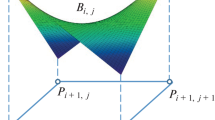Abstract
Traversal of hierarchial trees of extents (HTE) requires computation of intersections between rays and bounding volumes whose faces are parallel to the cartesian axes. By redefining the HTE so that nonoverlapping bounding volumes are generated, a well-behaved data structure is obtained in which “geometrical coherence” is applied to speed up its traversal. We distinguish two types of bounding volumes: internal boxes contain the ray's origin whileexternal bounding volumes do not contain the ray's origin. To traverse the HTE, we look first to polygons in the internal bounding volumes and deal with external boxes only when no ray-polygon intersection is found in internal nodes. As external nodes in the HTE define pruned subtrees of external bounding volumes, geometrical characteristics of the boxes are exploited for HTE traversal. A coding scheme allows a 6-bit code to determine which faces of a bounding volume need to be tested for intersection. Also, our well-behaved HTE allows for reuse of intersection points at lower levels of the tree.
Similar content being viewed by others
References
Amanatides J (1984) Ray tracing with cones. Proc SIGGRAPH '84, pp 129–135
Appel A (1968) Some techniques for shading machine-renderings of solids. SJCC, Thompson Books, Washington DC, pp 37–45
Arvo J, Kirk D (July 1987) Fast ray tracing by ray classification. Comput Graph (Proc SIGGRAPH), pp 55–64
Caspary E (1988a) Sequential and parallel algorithms for ray tracing complex scenes. Doctoral dissertation, Univ California, Santa Barbara, Calif
Caspary E (1988) Multiprocessing for ray tracing: a hierarchial self-balancing approach. Visual Computer 4(4)
Cook RL, Torrance K (1982) A reflectance model for computer graphics. ACM Trans Graph 1:7–24
Cook RL, Porter T, Carpenter L (1984) Distributed ray tracing. Proc SIGGRAPH '84, pp 137–145
Crow F (1987) The origins of the teapot. CGA, pp 8–16
Deguchi H, Shirakawa I, Omura K, Nishida M, Nishimura H, Kawata T (1986) A tree-structured parallel processing system for image generation by ray tracing. Trans Inst Electron Commun Eng J 69D:170–179
Foley J, Van Dam A (1983) Fundamentals of interactive computer graphics. Addison-Wesley, Philippines, pp 146–148, 575–622
Goldsmith J, Salmon J (1987) Automatic creation of object hierarchies for ray tracing. CGA, pp 14–20
Gaudet S, Hobson R, Chilka P, Calvert T (1988) Multiprocessor experiments for high speed ray tracing. ACM Trans Graph, pp 151–179
Glassner A (1988) Spacetime ray tracing for animation. CGA, pp 60–70
Glassner A (1984) Space subdivision for fast ray tracing. CGA, pp 15–22
Hoffman D (1988) Using octree space subdivision to accelerate ray tracing heavily populated scenes. Junior independent work, Princeton University, Princeton, NJ
Jansen FW (1985) Data structures for ray tracing. Proc Data Structures for Raster Graphics Workshop, pp 24–28
Kaplan M (1985) The uses of spatial coherence in ray tracing. ACM SIGGRAPH'85 Course Notes 11, July 22–26
Kay T, Kajiya JT (1986) Ray tracing complex scenes. Computer Graph (Proc SIGGRAPH), pp 269–278
Kuchkuda R (1988) An introduction to ray tracing. In: Earnshaw RH (ed) Theoretical foundations of computer graphics and CAD. Springer, Berlin Heidelberg New York, pp 1039–1060
Phong BT (1975) Illumination for computer generated pictures. CACM, pp 311–317
Rogers DF (1985) Procedural elements for computer graphics. McGraw-Hill, New York, pp 113–115, 152–155
Rubin SM, Whitted T (1980) A 3-dimensional representation for fast rendering of complex scenes. Computer Graphics (Proc SIGGRAPH), pp 110–116
Samet H, Tamminen M (1985) Computing geometric properties of images represented by linear quadtrees. IEEE Trans Pattern Anal, Mach Intell, pp 229–240
Samet H, Webber R (1988a) Hierarchical data structures and algorithms for computer graphics: I. Fundamentals. CGA, pp 48–68
Samet H, Webber R (1988b) Hierarchical data structures and algorithms for computer graphics: II. Applications. CGA, pp 59–75
Scherson ID, Caspary E (1987) Data structures and the time complexity of ray tracing. The Visual Computer 3:201–213
Sutherland IE (1974) Reentrant polygon clipping CACM 17:32–42
Sedgewick R (1988) Algorithms, 2nd edn. Addison-Wesley, pp 126–130, 347–356
Weghorst H, Hooper G, Greenberg DP (1984) Improved computational methods for ray tracing. ACM Trans Graph, pp 52–69
Whitted T (1980) An improved illumination model for shaded display. CACM,pp 343–349
Author information
Authors and Affiliations
Rights and permissions
About this article
Cite this article
Charney, M.J., Scherson, I.D. Efficient traversal of well-behaved hierarchical trees of extents for ray-tracing complex scenes. The Visual Computer 6, 167–178 (1990). https://doi.org/10.1007/BF01911007
Issue Date:
DOI: https://doi.org/10.1007/BF01911007




